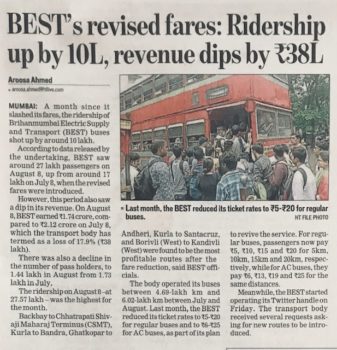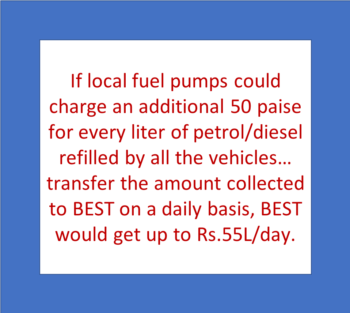 A bus ride in Mumbai’s public bus run by BEST could cost you up to Rs.40 for a single trip.
A bus ride in Mumbai’s public bus run by BEST could cost you up to Rs.40 for a single trip.
Not anymore!
From July 7, BEST slashed the fares by more than half, bringing the base fare for a 5-km journey down to just Rs.5. Daily ridership has surged 60% within a month – from 17L to 27L.
There can be no stronger evidence that affordable public transport encourages commuters to abandon their private vehicles. This also tells us that 10 Lakh commuters chose bus over other alternatives – auto, car or a two-wheeler. They reduced their own carbon footprint, and helped the city generate less vehicular pollution. This is fantastic news!
About time this is taken up as a mission. Across other cities as well.
However, there’s a hurdle. Financial viability of public transport in light of declining revenue. And increased losses.
BEST saw its daily inflow dip 19%, from Rs.2.12 Cr to 1.74 Cr, a shortfall of Rs.38L. Annually, this would be a mammoth Rs.140 cr. In fact, the shortfall can easily slip BEST into a deep hole. And if no one takes responsibility for covering the shortfall, we could be back to high fares, turning these very commuters back to their personal vehicles. Pity.
Can this shortfall be met?
Yes. I have a simple solution.
Everyone using personal transport must pay to keep public transport affordable. For several reasons. They must compensate for their carbon footprint. For example, a car emits up to 300 mg of Carbon Monoxide for every km it’s driven. Personal vehicles occupy space on roads, create congestion and end-up slowing down not only public buses but traffic speed as well.
Here’s how to collect:
All local fuel pumps could charge an additional 50 paise for every liter of petrol/diesel refilled. The amount collected must be dutifully transferred to BEST on a daily basis. My back of the envelope calculations indicate the private vehicles alone can contribute up to Rs.55L/day. (Sorry, I couldn’t find actual stats, if you have please share).
A perfect win-win. Small contribution from vehicles can help BEST keep the fares low. Any surplus collected can be invested into its fleet upgradation. Which would create a virtuous circle: more and more people opt for improved, more affordable public transport, leading to reduction in private vehicles. Consequently reducing both traffic and congestion, and eventually pollution.
Undoubtedly, supporting and strengthening this wonderful initiative can make our cities cleaner. Or may I say, more livable?

